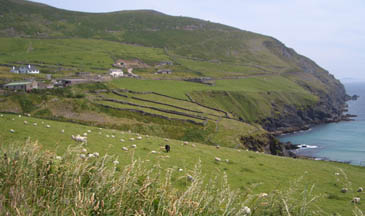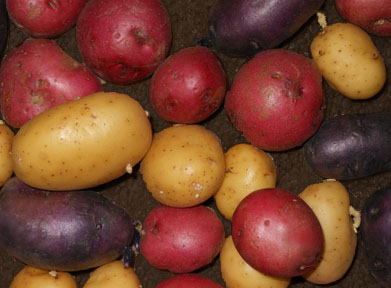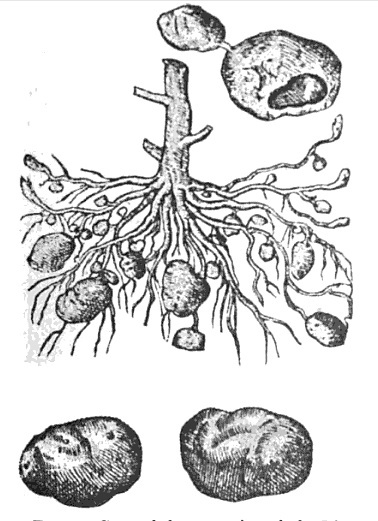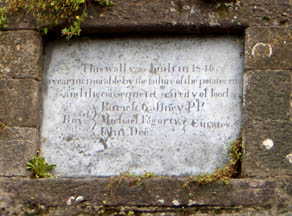 Dingle
Peninsula,
Ireland
photo by Cheryl Christenson 2006 |
Ireland
The Potato and the Famine by Elroy Christenson |
 Dingle
Peninsula,
Ireland
photo by Cheryl Christenson 2006 |
Ireland
The Potato and the Famine by Elroy Christenson |
The lowly potato was both a boon
to a hungry population and a cause of starvation. Its importation
into Europe from the South  America by Columbus was
first cultivated as a curiosity. When its flavor and sustaining
abilities were finally recognized and promoted; it quickly became
a staple of northern European communities.
America by Columbus was
first cultivated as a curiosity. When its flavor and sustaining
abilities were finally recognized and promoted; it quickly became
a staple of northern European communities.
The Peruvians had developed over
5000 varieties of potatoes. They grew them in every
elevation from sea level to the upper levels of the Andes.
In the early 1500's English may have picked it up from Spanish
vessels, brought it to Virginia. From 1585 or 1586 the
potato was brought from North Carolina to Ireland. [Gilbert 16]
Until about 1772 the potato was seen mostly as a food for domestic
animals. French philosopher-critic Denis Diderot said, "No
matter how you prepare it, the root is tasteless and
starchy". Ironically, it was a French pharmacist Antoine
Parmentier, who popularized the wonders of the potato after
1763. Once adopted it solved many of the reoccurring famines in
the rural areas of France. Thomas Jefferson, after being a guest
at social gatherings in France brought French fries to the
colonies. [Mann. Smithsonian 94] photo
Elroy Christenson, 2011
The Irish poor soil, cool
climate and deep need forced its development as human food. It was
so productive and popular in Ireland that it became known as the
"Irish Potato."  It was dominantly grown in Belgium, Germany, Poland,
Russia, England and Ireland where other hot weather crops such as
corn, also an import, had difficulty. The potato was probably
responsible for the population explosion in northern Europe after
the Renaissance. It did eliminate the famines that had been a
regular visitor to these communities. With the potato their
abilities to sustain themselves along with uncontrolled birthrates
simply produced more surviving individuals, which produced ever
more children.
It was dominantly grown in Belgium, Germany, Poland,
Russia, England and Ireland where other hot weather crops such as
corn, also an import, had difficulty. The potato was probably
responsible for the population explosion in northern Europe after
the Renaissance. It did eliminate the famines that had been a
regular visitor to these communities. With the potato their
abilities to sustain themselves along with uncontrolled birthrates
simply produced more surviving individuals, which produced ever
more children.
Ireland was used as an agrarian country to
provide cheap food products to England until the nineteenth
century. Much of the land was actually owned by the English
lords. The people were kept in almost a feudal relationship to
the land and their landlord. All the soil of Ireland was owned
by British or Irish Protestants until 1793.[Durant, v.11, p.507]
In the early 1800's about half the people lived on small farms
that produced little income. Many others had to rent the land
they farmed from landlords that charged them high rents.
the
Virginia Potato" by John Gerard 1663 [Gilbert]
| Although
England
itself was becoming industrialized, little
industrialization of Ireland happened until modern times.
What did exist was a life of misery. "In the factory
districts of Dublin poverty was even worse than on the
land. Irish industry was choked by high duties that
prevented the import of raw cotton, and by commercial
regulations that to a large extent prevented Irish
products, except linen(which was largely produced in
northern Ireland-EC), from competing with British products
within the Empire. Shelley, seeing the condition of Dublin
factory workers in 1812, wrote: 'I had no conception of
the depth of human misery until now.' " [Durant, v.11,
p.508] Along with the crushing poverty, there were also religious discrimination and political injustice. Representation in the Irish Parliament was restricted only to Protestants. This lack of equal representation and religious freedom brought about a number of rebellions that were brutally put down. It wasn't until 1829 when Catholic men had the right to serve in the British Parliament. The Irish Free State wasn't created until 1920. |
 Plaque
to the "Potatoe Famine"
in Carrick-en-Sur, Ireland "This wall was built in 1846 a year memorable by the failure of the potatoe crop and the consequent scarcity of food" signed with the three names of Rev. |
This life of poverty and injustice created
an almost total dependence on the easily and cheaply grown
potato. Beginning in 1845 through to 1847 a "potato blight"
disease struck the potato fields and killed off most of the
plants. In 1845 2.1 million acres of potatoes were planted in
Ireland. "In one month P.
infestans wiped outh the equivalent of one-half to
three-quarters of a million acres. The next year was worse, as
was the year after that."[Mann 100] Any plants that produced a
crop were soon spoiled and replanting in the diseased fields
continued the devastation for several seasons until all seed
potatoes were either eaten or used futilely in plantings. About
750,000 to one million people died of starvation or disease.
Hundreds of thousands of Irish people left the country, many
coming to the United States with what ever hope and money they
could scrap together. Immigration from Ireland was continuous
with the main wave of Irish immigration happening in the 1840's
and 1850's when almost 1.5 million people came to the United
States.
Liverpool was the dominate port of
departure of most immigrants from the British Isles. The
Irish had regularly worked in Liverpool during the summer
harvest so may have been well versed as to some of the things
they could expect. Others may have been straight from the
rural area and in awe of the big cities of Dublin and
Liverpool. Liverpool was one of the world's busiest ports
with 36 miles of quays and three times the tonnage of
America. Passage fares on the ships varied from day to
day. Steerage could cost between L3 10s to L5.
Shipping companies paid runners to scout for clients who then
might lead them to lodging or other services for a fee.
All the immigrants had to go before a "medical officer" who were
paid L1 for each hundred persons given a brief exam. The
search for stowaways began when towed down the river. Some
had hidden in barrels and bags and when discovered were returned
to shore on the tug. Most of the journey was done while
below decks due to the weather. [Laxton 236]
When they arrived at the port the immigrants had to run the gamut of scam artists who wanted to arrange transportation, lodging, jobs, food etc. "What with shipwrecks, what with deaths from famine, from fever, from overcrowding; what with wholesale robbery, committed upon them at almost every step of their journey, it is matter for great surprise indeed, that even a remnant of the Famine-emigrants survived to locate themselves in that far West, to which they fled in terror and dismay, from their humble but loved and cherished homes, in the land of their father. The Irish race get but little credit for industry or perseverance; but in this they are most unjustly maligned, as many testimonies already cited from friend and foe, clearly demonstrate. If one more be wanting, I would point to a fact in the history of the worn-out remnant of our Famine-emigrants, who had tenacity of life enough ot survive their endless hardships and journeyings. The fact is, the large sums of money which year after year, they sent to their friends - every penny of which they earned by the sweat of their brow - by their industry and perseverance. " [O'Rourke 331]
Our James Doyle (b.1825) family came from
Ireland on the ship "Saranak" on 30 May, 1849 with his brother
or cousin, Martin Doyle. They probably came with few if any
skills but adapted to any opportunity. He, like many of the new
immigrants, got a job building of a railroad. The huge influx of
Irish immigrants was not looked upon favorably by the other
earlier residents. They were often viewed as uneducated
job stealers because they were willing to do whatever it took to
stay alive. James Doyle used his gardening skills on a
small plantation in Smyth Co., Virginia prior to the Civil
War.
source:







All information and
photos included within these pages are here for the
express purpose of personal genealogical research and may
not be included or used for any commercial purpose or
included in any commercial site without the express
permission of Cheryl and Elroy Christenson. Copyright
Elroy Christenson 1998-2016.